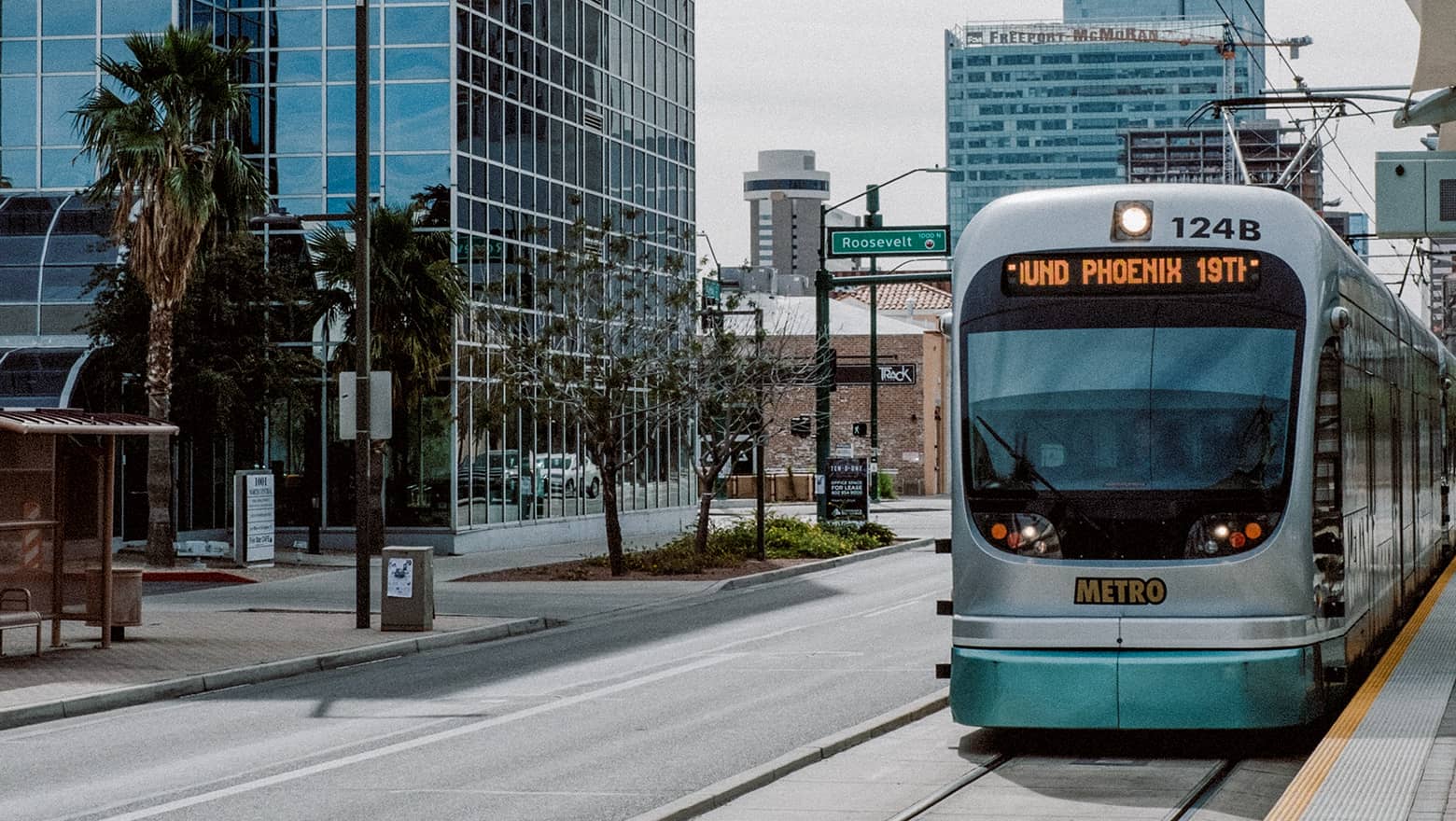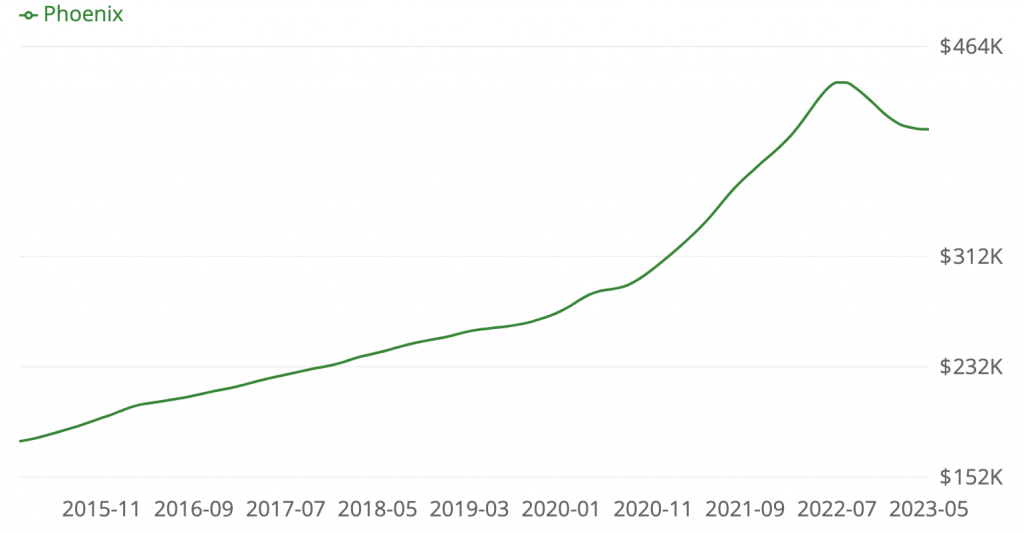Phoenix Housing Market: Trends & Prices

Phoenix Real Estate Market Overview
(Last Updated – 6/2023)
People flock to Phoenix for many reasons. Some are seeking a top-notch education; others want to retire in a warm locale. Families and young workers see the appeal of Phoenix too. It’s a city with a lot to offer, no matter who you are, but especially if you love warm weather.
Phoenix sees an average of 299 sunny days a year, whereas the country averages 205 days. Even on the days it isn’t sunny in Phoenix, there is a good chance the skies are clear. On average, Phoenix only has 33 days per year of precipitation such as rain, hail, sleet, or snow.
One of the fastest-growing American cities, Phoenix has been booming for a while. According to the latest 2022 census data, the city’s population rose by over 13% since 2010, earning Phoenix the title of fifth-largest city in the country. Housing prices here have also been on the rise so far this year, and experts are predicting further increases in the coming months.
If you’re raising a family, you can rest easy knowing that Phoenix has 325 public schools and 200 charter and private schools to choose from.
If you have teenagers or are looking to head back to school yourself, have no fear. There are over 140 colleges, community colleges, and trade schools in Arizona, many of which are located in or near Phoenix.
Overall Phoenix Market Trends
When it comes to local housing market trends, you may need to compete in Phoenix. Experts consider the housing market in Phoenix to be somewhat competitive, as some homes receive multiple offers and sell for 2% below list price.
Most houses go pending in around 45 days. In-demand homes in the city can sell over twice as fast, at 20 days on average.
$440,000
Median Sale Price
$277
Avg. Price Per Sq. Foot
42 days
Avg. Time on Market
Phoenix Housing Market Forecast
Like the weather, the Phoenix housing market is hot so far in 2023. While May home prices went down 6.4% in the Phoenix metro area compared with the prior year, prices have been rising steadily since February 2023, and real estate experts see no sign of things cooling down this year.

Demand in Phoenix
With inventory low and buyer demand high, real estate experts say that Phoenix continues to be a seller’s market.
Despite rising home prices, Phoenix remains relatively affordable, with a cost of living at only 4.3% above the national average, according to the Council for Community and Economic Research’s 2022 Q2 Cost of Living Index. It is also worth noting that median home prices in Phoenix are lower than some other big cities’, like Los Angeles and Portland.
If you are looking to buy into the Phoenix market, real estate experts suggest that this could be a good long-term opportunity if you find a property in your budget.
Recommended: Home Ownership ResourcesDemographics of the Phoenix Market
Arizona may be known as a hotspot for retirees who are looking to enjoy the warm weather, but plenty of young people populate this state too. More than a third of the Phoenix populace is under 18 years old, according to the latest census data.
Young adults are drawn to the area thanks to popular schools like Arizona State University. If the housing market in Phoenix is calling your name, consider these demographics.
Median Income: $64,927
Median Age: 34.1
College Educated: 30.6%
Homeowners: 56.1%
Married: 44.7%
Popular Phoenix Neighborhoods
Phoenix offers a diverse group of neighborhoods to choose from, so do your research before deciding which may be right for you.
The cost of homes, average household income, and age of residents can vary greatly by neighborhood, of course, but chances are there is a spot that will check all your boxes.
Recommended: Price-to-Rent Ratio in 50 CitiesParadise Valley
This high-end neighborhood has been around for over 50 years and prioritizes quiet surroundings, open space, and privacy. Paradise Valley is primarily car-dependent, so keep that in mind when looking at homes in this neighborhood.
Quick Facts
Population:
12,666
Median Age:
54.4
Housing Units:
5,816
Bike Score:
45/100
Walk Score:
14/100
Transit Score:
N/A
Average Household Income:
$359,522
Paradise Valley Housing Market
Experts consider the Paradise Valley housing market not very competitive, and it is worth noting that home values in this area dropped 4.7% in May 2023 compared to last year. However, the median sale price per square foot shot up 16% since last year.
Many homes sell for about 5% below list price and go pending in 68 days.
Median Sale Price
$3,775,000
Average Price Per Sq. Foot
$785
Downtown Phoenix
For families or singles who like to stay busy, Downtown Phoenix has a lot to offer. Theater, art, a science center, and historical architecture are all accessible, as are world-class dining options, bars, and a baseball stadium to help you fill your weekends.
Quick Facts
Population:
7,152
Median Age:
33
Housing Units:
4,302
Bike Score:
72/100
Walk Score:
82/100
Transit Score:
63/100
Average Household Income:
$84,239
Downtown Phoenix Housing Market
You may find more homes in your price range downtown than in other Phoenix neighborhoods.
This has been a somewhat competitive market, with a few homes receiving multiple offers and average homes going for roughly 2% below list price.
Median Sale Price
$485,000
Average Price Per Square Ft.
$430
Stetson Valley
If you’re looking for a family-friendly neighborhood, you might want to check out Stetson Valley.
This community has over 15 parks that feature toddler play areas and splash pads to help beat the summer heat.
Quick Facts
Population:
19,744
Median Age:
40.7
Housing Units:
6,782
Bike Score:
43/100
Walk Score:
7/100
Transit Score:
N/A
Average Household Income:
$158,811
Stetson Valley Housing Market
Home prices are a bit up and down in Stetson Valley. In May 2023, the average home price dropped by 11.6% compared to the same month in the previous year.
Houses generally spend 63 days on the market.
Median Sale Price
$635,000
Average Price Per Square Ft.
$217
Coronado
Coronado is a large neighborhood with three smaller neighborhoods within it: Historic Coronado, Country Club Park, and Brentwood.
This area is home to hundreds of businesses and offers close proximity to State Road 51 and Interstate 10.
Quick Facts
Population:
266,413
Median Age:
50
Housing Units:
127,793
Bike Score:
60/100
Walk Score:
73/100
Transit Score:
49/100
Average Household Income:
$83,644
Coronado Housing Market
Be ready to bid if you’re looking to buy in Coronado. Sometimes listed homes receive multiple offers. The average home typically sells for 3% below list price and goes pending in about 77 days.
Median Sale Price
$530,000
Average Price Per Square Ft.
$376
Deerview
This area of Phoenix is ideal for those who enjoy walking to their favorite spots. There are over 20 restaurants, bars, and coffee shops to choose from, most of which residents can walk to in five minutes.
Quick Facts
Population:
23,598
Median Age:
38
Housing Units:
9,771
Bike Score:
48/100
Walk Score:
56/100
Transit Score:
40/100
Average Household Income:
$77,371
Deerview Housing Market
In May 2023, home prices in Deerview dropped by 3.4%. Houses in this area stay on the market for about 63 days.
Median Sale Price
$425,000
Average Price Per Square Ft.
$208
SoFi Home Loans
It’s easy to see why Phoenix has become such a popular market to buy a home in. There are some really amazing neighborhoods to choose from whether you’re young and single or have a family to look after.
If you think Phoenix could be your home sweet home, then you may need to consider your mortgage financing options.
If you’re buying a home or refinancing an existing mortgage, SoFi can help you make the process as quick and painless as possible.
SoFi Loan Products
SoFi loans are originated by SoFi Bank, N.A., NMLS #696891 (Member FDIC). For additional product-specific legal and licensing information, see SoFi.com/legal. Equal Housing Lender.
SoFi Mortgages
Terms, conditions, and state restrictions apply. Not all products are available in all states. See SoFi.com/eligibility for more information.
Third-Party Brand Mentions: No brands, products, or companies mentioned are affiliated with SoFi, nor do they endorse or sponsor this article. Third-party trademarks referenced herein are property of their respective owners.
SOHL20010